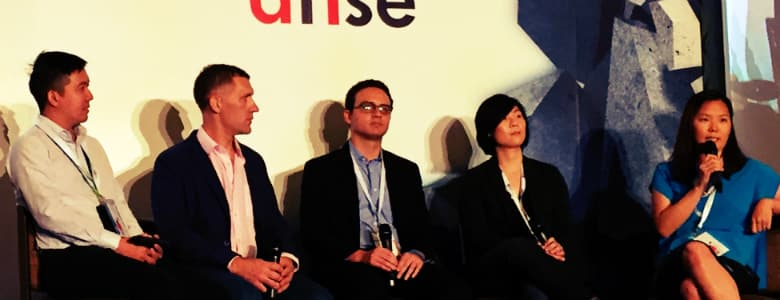Smart moves for Smart Mobility

What every working person hopes for in the morning, apart from a good cup of coffee, is a smooth journey into work.
One that’s cool, comfortable and — most importantly — convenient.
In just a few years, that journey could look something like this: a lift on GrabShare to the closest train station, a quick hop on the MRT, followed by a driverless shuttle ride to the office.
It’s a vision of the not-so-distant future — one that players in both the public and private sectors are working towards.
“Singaporeans have high expectations and demands for transportation,” said Mr Liu Feng-Yuan, Director of GovTech’s Government Digital Services Data Science Division.
He was speaking on 3 May 2017 at the InnovFest Unbound festival, as part of a four-person panel to discuss the topic of intelligent mobility. The festival, organised by NUS Enterprise and now in its third year, claims to be the place “where Asian Innovation meets the World.”
“I think what commuters really want is a seamless experience,” said Mr Liu.
A multi-modal transport system
As technologies improve, we edge further into an era of ‘smart mobility’, where infrastructure, transportation and travellers are increasingly interconnected.
It’s that sense of integration, the panelists agreed, that will help make the commuter’s journey seamless.
“The question is: how do you make the experience something you don’t have to think about?” asked Mr Liu.
For one, we need to tackle the numerous booking and payment systems that currently exist, which make for a fragmented experience, observed Ms Karen Tay, Director of Smart Nation’s North America office, who chaired the panel.
But before that, we need to stop thinking of transportation in the digital era as something planned or static, said Mr Liu.
While transport infrastructure has traditionally been seen as physical rail lines or bus stops, the reality today is that it is much more organic.
For example, with on-demand, ride-hailing services like Grab cars and SWAT shuttles, travellers aren’t bound by fixed routes or timetables anymore, he added.
“For me, the next great thing in transport is that we’ll use public and private systems in an interchangeable way,” shared another panelist, Ms Xin Wei Ngiam.
The Director of Strategy at Grab, a major ride-hailing player, added: “It’ll be multi-modal, using many different forms of transport and with different players providing different types of services.”
A thousand flowers blooming
Having numerous transport companies may seem contrary to the aim of providing a unified consumer experience, but panelist Mr Nick Jachowski, co-founder of mobility tech company SWAT, says it’s necessary for now.
“We know that the transportation landscape is going to undergo seismic shifts,” said Mr Jachowski, whose company offers taxi ride-sharing services. “Nobody knows exactly what it’s going to look like in the future, so that’s why everyone is placing all these different bets on different companies, technologies and visions.”
Fellow panelist Mr Doug Parker, COO of nuTonomy, agreed. There’s plenty of room for the mobility market to grow and for more contenders to enter the fray, he said, pointing out that the market will be worth an estimated $3-5 trillion in the next five years.
Autonomous vehicles are one way forward, and nuTonomy is testing self-driving technology both in Boston and in Singapore’s one-north business park.
“Right now, we’re in this stage where a thousand flowers are blooming in the mobility space,” commented Smart Nation’s Ms Tay.
A city that flows
Many assume that the transportation industry’s research and testing revolves around meeting the traveller’s needs. But the reality of smart mobility is that new technologies also enable many things other than helping people get to their destinations as quickly as possible.
For example, they also allow transport providers to optimise safety and reduce operational costs, and city planners to attain efficiency while minimising environmental pollution.
“The core of that technology is mobility optimisation,” said SWAT’s Mr Jachowski.
“We’re trying to move the highest number of people with the lowest number of vehicles, for the greatest public good. The vision we have is to use technology to move people in the most efficient way, so that the city really flies.”
nuTonomy has a similar aspiration, said Mr Parker. “Our goal is to help Singapore reduce car ownership, and to make sure that we’re not increasing traffic along public expressways and roads.”
Singapore, it seems, is an ideal setting to implement this strategy. With less than 10 percent of individuals owning cars, Singapore has the lowest car penetration of any major city, said Mr Jachowski, who grew up in the US.
“Try getting people like my dad to not use his car. It’s not going to happen,” he said, drawing laughter from the nearly 200-strong audience.
“We as the government want a car-lite society with people sharing vehicles,” said Mr Liu at the end of the session. “We don’t want the kind of gridlock you get in many other cities.”
“We want commerce to flow,” Mr Liu said. “Mobility is essential because we think mobility and connectivity are archways for economic trade within the city.”
https://www.tech.gov.sg/media/technews/smart-moves-for-smart-mobility
